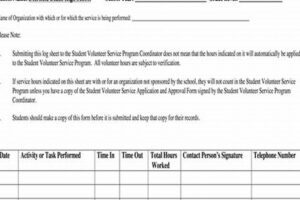Table of Contents
The key to successful volunteer management lies in effective organization and communication. A well-structured volunteer sign up sheet template can streamline the process of recruiting, scheduling, and managing volunteers. This comprehensive guide provides you with a step-by-step approach to creating a user-friendly and informative sign up sheet, ensuring a smoother volunteer management experience.
A volunteer sign up sheet serves as a central hub for volunteers to express their interest in specific tasks or shifts. It allows you to gather essential information such as contact details, availability, and skills. By providing a clear and concise sign up sheet, you can attract potential volunteers and make it easy for them to join your cause.
In the subsequent sections, we will delve into the key elements of an effective volunteer sign up sheet template. We will cover everything from designing the layout to incorporating essential fields and providing clear instructions. By following these steps, you will be able to create a sign up sheet that meets the unique needs of your organization and attracts a dedicated pool of volunteers.
volunteer sign up sheet template
Create a well-structured volunteer sign up sheet.
- Clear and concise layout
- Essential fields for information
- Include contact details
- Availability and skills
- Task or shift preferences
- Emergency contact information
- Waiver and liability release
- Instructions and guidelines
- Option for digital signatures
- Easy to share and access
By incorporating these important points, you can design a volunteer sign up sheet template that is both informative and user-friendly.
Clear and concise layout
A clear and concise layout is essential for an effective volunteer sign up sheet template. Volunteers should be able to easily understand the purpose of the sheet and the information required from them. Here are some tips for creating a clear and concise layout:
1. Use a simple and uncluttered design: Avoid using excessive graphics, colors, or fonts that may distract from the content. Keep the layout clean and organized, making it easy for volunteers to navigate.
2. Group related information together: Organize the sign up sheet into logical sections, grouping related information together. For example, you could have a section for personal information, a section for availability, and a section for task preferences.
3. Use clear and concise language: Avoid using jargon or technical terms that may not be familiar to all volunteers. Use simple, straightforward language that is easy to understand.
4. Provide clear instructions: Include clear instructions at the top of the sign up sheet, explaining the purpose of the sheet and how volunteers should fill it out. You may also want to include a section for frequently asked questions (FAQs) to address common queries.
By following these tips, you can create a clear and concise volunteer sign up sheet template that makes it easy for volunteers to sign up for opportunities and for you to manage your volunteer program.
Essential fields for information
The essential fields for information on a volunteer sign up sheet template may vary depending on the specific needs of your organization. However, there are some general fields that are typically included:
- 1. Name: Volunteers should provide their full name, including first and last name.
- 2. Contact information: This may include email address, phone number, and mailing address. Make sure to specify which method of contact you prefer.
- 3. Availability: Volunteers should indicate their availability for volunteering, including days and times they are available. You may want to provide a calendar or grid where volunteers can mark their availability.
- 4. Skills and interests: Volunteers can list their skills, experience, and interests. This information can help you match volunteers with appropriate opportunities.
Other essential fields may include:
- Emergency contact information: In case of an emergency, it is important to have contact information for a volunteer’s emergency contact.
- Waiver and liability release: Many organizations require volunteers to sign a waiver and liability release form before they can participate in volunteer activities.
Include contact details
Contact details are essential for staying in touch with volunteers and keeping them informed about volunteer opportunities and events. Here are some tips for including contact details on a volunteer sign up sheet template:
1. Collect multiple forms of contact information: In addition to email addresses, you may also want to collect phone numbers and mailing addresses. This will ensure that you have multiple ways to reach volunteers, even if they do not have access to email.
2. Specify your preferred method of contact: Let volunteers know which method of contact you prefer. For example, you may prefer to be contacted by email or phone.
3. Keep contact information up-to-date: Volunteers’ contact information may change over time. Encourage volunteers to update their contact information regularly, or periodically send out a reminder to do so.
4. Use contact details responsibly: Only use volunteers’ contact information for volunteer-related purposes. Do not sell or share their information with third parties.
By following these tips, you can ensure that you have accurate and up-to-date contact information for your volunteers, which will help you to communicate with them effectively and keep them engaged.
Availability and skills
Collecting information about volunteers’ availability and skills can help you to match them with appropriate opportunities and ensure that you have the resources you need to run your programs and events successfully.
- 1. Availability: Ask volunteers to indicate their availability for volunteering, including days and times they are available. You may want to provide a calendar or grid where volunteers can mark their availability.
- 2. Skills and experience: Volunteers can list their skills, experience, and interests. This information can help you to match volunteers with appropriate opportunities that align with their skills and interests.
- 3. Specific skills: If there are specific skills that are required for certain volunteer roles, be sure to include a section on the sign up sheet where volunteers can indicate whether they have those skills.
- 4. Willingness to learn: Some volunteers may not have specific skills, but they may be willing to learn. Include a section on the sign up sheet where volunteers can indicate their willingness to learn new skills.
By collecting information about volunteers’ availability and skills, you can create a pool of qualified volunteers who are ready to help you achieve your goals.
Task or shift preferences
Allowing volunteers to indicate their task or shift preferences can help you to create a schedule that meets the needs of both your organization and your volunteers.
- 1. Specific tasks: Some volunteers may have a preference for specific tasks. For example, they may prefer to work with children, or they may prefer to do administrative work.
- 2. Shift times: Volunteers may also have preferences for shift times. For example, they may prefer to work mornings or evenings, or they may prefer to work on weekends.
- 3. Location: If your organization has multiple locations, volunteers may have a preference for working at a particular location.
- 4. Frequency: Some volunteers may be able to commit to volunteering on a regular basis, while others may only be able to volunteer occasionally. Allow volunteers to indicate their preferred frequency of volunteering.
By collecting information about volunteers’ task or shift preferences, you can create a schedule that is both efficient and satisfying for your volunteers.
Emergency contact information
Collecting emergency contact information is essential for the safety of your volunteers. In case of an emergency, it is important to have contact information for someone who can be reached to provide consent for medical treatment or to provide information about the volunteer’s medical history.
- 1. Name: Collect the full name of the emergency contact person.
- 2. Relationship to volunteer: Indicate the relationship of the emergency contact person to the volunteer, such as spouse, parent, or friend.
- 3. Contact information: Collect the emergency contact person’s phone number and email address. You may also want to collect their mailing address.
- 4. Availability: Ask the emergency contact person to indicate their availability to be reached in case of an emergency.
By collecting emergency contact information, you can ensure that you have the necessary information to reach a volunteer’s emergency contact in case of an emergency.
Waiver and liability release
A waiver and liability release is a legal document that protects your organization from liability in the event that a volunteer is injured or suffers damages while volunteering. It is important to have volunteers sign a waiver and liability release before they begin volunteering.
- 1. Explain the purpose of the waiver and liability release: Make sure that volunteers understand the purpose of the waiver and liability release and why it is important for them to sign it.
- 2. Use clear and concise language: The waiver and liability release should be written in clear and concise language that is easy for volunteers to understand.
- 3. Include essential information: The waiver and liability release should include essential information, such as the name of your organization, the date, and the volunteer’s signature.
- 4. Have volunteers read and sign the waiver: Volunteers should be given the opportunity to read and understand the waiver and liability release before they sign it.
By having volunteers sign a waiver and liability release, you can protect your organization from liability and ensure that volunteers are aware of the risks associated with volunteering.
Instructions and guidelines
Clear and concise instructions and guidelines can help volunteers to fill out the volunteer sign up sheet correctly and efficiently.
- 1. Provide step-by-step instructions: Break down the process of filling out the volunteer sign up sheet into a series of simple steps. Make sure to include instructions for each field on the sheet.
- 2. Use clear and concise language: The instructions and guidelines should be written in clear and concise language that is easy for volunteers to understand.
- 3. Highlight important information: Use bold or italics to highlight important information, such as deadlines or required fields.
- 4. Provide examples: If there are any fields that may be confusing, provide examples to help volunteers understand how to fill them out.
By providing clear and concise instructions and guidelines, you can ensure that volunteers have a positive experience filling out the volunteer sign up sheet and that you receive the information you need to manage your volunteer program effectively.
Option for digital signatures
In today’s digital world, it is convenient and efficient to offer volunteers the option to provide digital signatures on your volunteer sign up sheet template. Digital signatures allow volunteers to sign the sheet electronically, eliminating the need for printing, scanning, and mailing paper forms.
There are several benefits to offering digital signatures on your volunteer sign up sheet template:
- Convenience for volunteers: Volunteers can sign the sheet from anywhere with an internet connection, making it easier for them to participate in your program.
- Efficiency for your organization: Digital signatures streamline the process of collecting and managing volunteer information, saving you time and resources.
- Legally binding: Digital signatures are legally binding in most jurisdictions, providing the same level of security as traditional handwritten signatures.
To add the option for digital signatures to your volunteer sign up sheet template, you can use a variety of online tools and services. Some popular options include:
- Google Forms: Google Forms allows you to create and share online forms, and it includes the option for digital signatures.
- DocuSign: DocuSign is a cloud-based electronic signature service that allows you to send and receive documents for electronic signature.
- Adobe Sign: Adobe Sign is another popular electronic signature service that offers a variety of features for managing and tracking digital signatures.
By offering the option for digital signatures on your volunteer sign up sheet template, you can make it easier for volunteers to sign up and participate in your program, while also streamlining the process for your organization.
Easy to share and access
To ensure that your volunteer sign up sheet template is effective, it is important to make it easy for volunteers to share and access. Here are a few tips:
- Use a digital format: Create your volunteer sign up sheet in a digital format, such as a Google Sheet or Microsoft Excel spreadsheet. This will make it easy for volunteers to access and fill out the sheet from any device with an internet connection.
- Share the link widely: Once you have created your digital volunteer sign up sheet, share the link with potential volunteers via email, social media, and your organization’s website. You can also post the link in public places, such as libraries and community centers.
- Use social media: Social media is a great way to promote your volunteer sign up sheet and encourage people to sign up. Share posts about your volunteer opportunities and include a link to the sign up sheet.
- Make it mobile-friendly: Ensure that your volunteer sign up sheet is mobile-friendly so that volunteers can easily access and fill it out on their smartphones or tablets.
By following these tips, you can make your volunteer sign up sheet easy to share and access, which will help you attract more volunteers and fill your volunteer positions quickly and easily.
An easy-to-share and accessible volunteer sign up sheet can make a big difference in the success of your volunteer program. By making it easy for volunteers to find and fill out the sheet, you can increase the number of volunteers who sign up and participate in your program.
FAQ
If you have questions about volunteering, here are some frequently asked questions and answers:
Question 1: How do I find volunteer opportunities?
Answer 1: There are many ways to find volunteer opportunities. You can search online, contact local organizations directly, or attend volunteer fairs.
Question 2: What skills are needed to volunteer?
Answer 2: The skills needed to volunteer vary depending on the opportunity. However, some common skills that are valued by organizations include communication, teamwork, problem-solving, and a willingness to learn.
Question 3: How much time do I need to commit to volunteering?
Answer 3: The time commitment required to volunteer varies depending on the opportunity. Some opportunities may require a few hours per week, while others may require a more significant commitment.
Question 4: Can I volunteer if I have a criminal record?
Answer 4: The ability to volunteer with a criminal record depends on the organization and the specific opportunity. Some organizations may have restrictions on volunteers with criminal records, while others may be more lenient.
Question 5: What are the benefits of volunteering?
Answer 5: There are many benefits to volunteering, including gaining new skills, meeting new people, giving back to the community, and improving your overall health and well-being.
Question 6: How can I make the most of my volunteer experience?
Answer 6: To make the most of your volunteer experience, be prepared, ask questions, be open to new experiences, and be grateful for the opportunity to serve.
These are just a few of the frequently asked questions about volunteering. If you have additional questions, please don’t hesitate to contact a volunteer organization or visit a volunteer website for more information.
In addition to the FAQ, here are some additional tips for volunteers:
Tips
Here are a few tips to help you get started as a volunteer:
Tip 1: Choose a cause that you are passionate about. When you are passionate about a cause, you are more likely to be motivated and engaged in your volunteer work.
Tip 2: Find a volunteer opportunity that matches your skills and interests. There are many different volunteer opportunities available, so you are sure to find one that is a good fit for you.
Tip 3: Be prepared to commit to your volunteer role. Volunteering is a commitment, so be sure that you are prepared to give your time and energy to the role.
Tip 4: Be open to new experiences. Volunteering is a great way to learn new skills and meet new people. Be open to trying new things and stepping outside of your comfort zone.
These are just a few tips to help you make the most of your volunteer experience. By following these tips, you can find a volunteer opportunity that is meaningful to you and make a real difference in your community.
Volunteering is a rewarding experience that can benefit both you and the community. By following these tips, you can make the most of your volunteer experience and make a positive impact.
Conclusion
Volunteering is a great way to give back to your community, meet new people, and learn new skills. By following the tips in this article, you can find a volunteer opportunity that is a good fit for you and make the most of your experience.
Remember, volunteers are the backbone of many organizations and play a vital role in making a difference in the world. Your time and effort are greatly appreciated.






